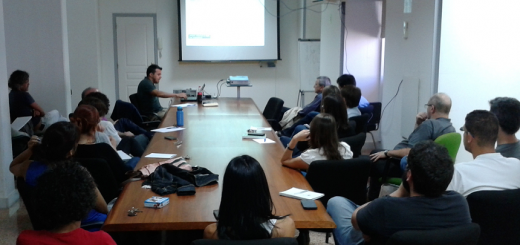A new method for nocturnal aerosol measurements with a lunar photometer prototype
A new methodology to measure and characterize aerosols during nighttime with a Lunar photometer developed by Cimel Electronique is presented in a paper recently published in Atmospheric Measurement Techniques Discussions (AMTD).

Two Lunar Cimel photometer prototypes taking moon measurements at Izaña Atmospheric Observatory.
Atmospheric aerosols are known to impact the climate evolution but they still represent one of the largest uncertainties in climate change studies. The high uncertainty associated to the role played by aerosols in radiative forcing on a global scale makes it necessary to obtain a global ground-based aerosol climatology. In this sense, the AErosol RObotic NETwork (AERONET) is nowadays one of the most powerful worldwide tool.
Aerosol Optical Depth (τa) at a certain wavelength is the standard parameter derived from sunphotometers, such as the Cimel CE-318 operating in AERONET. They perform continuous and globally distributed observations to characterize atmospheric aerosols at daytime. However the lack of nighttime aerosol observations introduces some uncertainties in column aerosol estimations. Nighttime τa is a necessary parameter to obtain a continuous sequence of total column aerosol information which is of considerable importance for monitoring aerosol transport, for high latitude locations, given the extended periods of darkness during winter, to study the effect of aerosol particles on cloud lifetime and coverage during the night, and for detecting massive aerosol outbreaks at night. In addition, τa obtained from ground-based stations are used to provide independent and trustable validation to satellite-based aerosols products and to regional and global aerosol/dust models.
Despite nocturnal τa observations are strongly required, the use of common-aperture lunar photometers is very limited nowadays. This technique presents important complexities and limitations in determining the instrument calibration due to the low incoming energy from the moon, the variation of the moon’s illumination inherent to the lunar cycle as well as the non-lambertian reflectance properties of this celestial body, related to its surface composition and viewing geometry. These problems were tackled in a new study recently published in the Atmospheric Measurement Techniques Discussions (AMTD). It presents the preliminary results of a nocturnal aerosol characterization using a new instrument developed by Cimel Electronique and tested at the Izaña Atmospheric Research Center. This is a new lunar photometer, trade name CE-318U due to the similarities with the classical sunphotometer CE-318 (standard of AERONET), specifically designed to perform automatic lunar irradiance measurements. Three different methods have been proposed in this study to assess the instrument calibration. Firstly, the Lunar Langley Method consists on the adaptation of the usual Langley-plot Method to nocturnal measurements to account for the moon’s irradiance variation. The other two methodologies involve the calibration transference from a master photometer (Method 2) and the use of an integrating sphere to determine calibration coefficients (Method 3).
Figures 1 and 2 show the daily τa evolution using the Lunar Langley Method in two case studies. The first one (Figure 1) is a six days and five nights period in August, 2011, in which several saharan dust intrusions affected the station. It can be seen that the changes in aerosol concentrations is well captured by CE-318U within the τa accuracy limit established in AERONET (±0.01 for longer wavelength channels and ±0.02 for those centered at 440 nm and 500 nm). The performance of this new instrument was checked in a low and stable τa event on 8-9 February 2012 (Figure 2). Reduced τa variations during moonrise, even lower than the expected instrument’s precision, were well captured by CE-318U.
Results from Method 2 showed similar precisions than Method 1. However, higher uncertainties were found affecting to Method 3.
This work concludes that this new photometer is capable to perform an accurate aerosol characterization at night, and then it could be used as complementary instrument to expand the column aerosol observations in operational networks as well as to enhance the operational capability of the AERONET database.
Further details about this study can be found in the on-line paper:
Barreto, A., Cuevas, E., Damiri, B., Berkoff, T., Berjón, A. J., Hernández, Y., Almansa, F. and Gil, M.: A new Method for nocturnal aerosol measurements with a lunar photometer prototype, Atmospheric Measurement Techniques Discussions. Link.
Fig. 1: τa evolution during six days and five nights on August, 2011, using AERONET data for daytime and lunar CE-1 data for nocturnal period. MPL corrected backscatter cross-sections obtained at Santa Cruz station in upper panel. The white line represents the Izaña Observatory level.
Fig. 2: τa evolution on 8-9 February 2012, with MPL corrected backscatter cross-sections. The white line represents the Izaña Observatory level.





